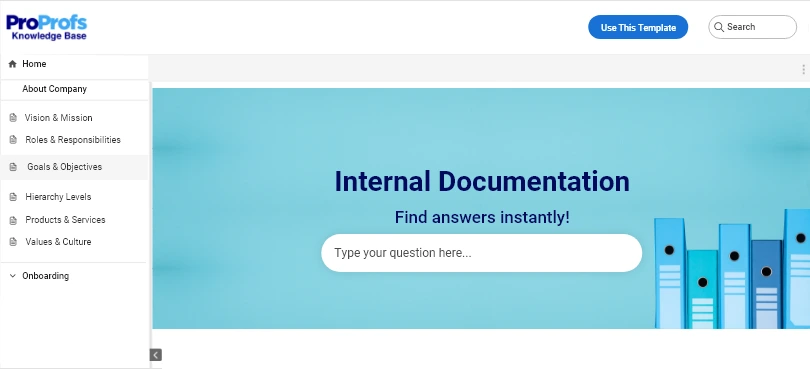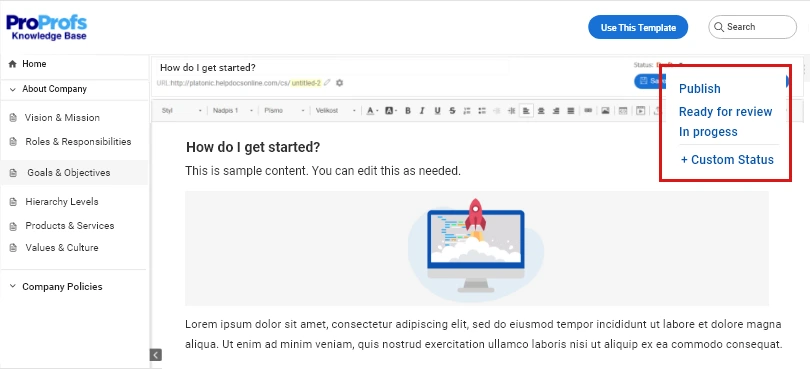
Disengaged and unproductive workforce are the two major concerns of companies today.
These problems get bigger and bigger, if not analyzed and solved at the ground level. The lack of a proper system to share and access information is the cause of these problems, which further impacts team communication, innovation, and creativity.
Creating internal documentation can bring some relief. Let’s see how!
It is a centralized hub where you can store all critical business information related to your clients, projects, work processes, policies, etc. Employees can access everything they need from a single platform, which saves them tons of time and effort at work.
This convenience translates into higher productivity, improved communication, and collaboration.
Read this blog to learn everything you should know about internal documentation, its types, benefits, and how it can be created.
Let’s go!
What Is Internal Documentation?
Internal documentation is an online company-wide platform where you can store important business information about your company’s history, vision and mission, clients, projects, teams, and much more. It is a common point where teams can access information to make smarter decisions and get work done quickly.
As an internal platform, it can be accessed only by your employees through secure login credentials. The ultimate aim of this document is to help employees work with optimum efficiency by equipping them with the right information at the right time.
Types of Internal Documentation
You can create several types of internal documentation, depending on your needs and preferences. Let’s take a look at some of these:
Project Documentation
Despite documentation being essential to streamline communication and drive decision-making, very few companies have proper documentation in place.
This is major because companies are still not aware of the huge benefits they can derive from the documentation.
Process Documentation
Process documentation provides step-by-step instructions on how to carry out a process in the most seamless way possible. It includes how-to articles, step-by-step guides, and instructional videos to guide employees on the right path to accomplish a task. When you have standardized work processes documented together, the chances of errors reduce to a minimum.
HR Documentation
This document acts as a one-stop portal for your HR team to access details about your recruitment process, hiring policies, employee directory, and previous records. This document is vital to maintain the sanity and productivity of HR folks as it saves them from multiple email threads and back-to-back meetings.
Read More: Improve Your Human Resources Operations With HR Documentation
Training Documentation
Training documentation is meant to train employees on how to perform well in their roles. It empowers them with all necessary information pertaining to your products and services, work policies, client details, and industry-related subjects. Using this document, employees can train themselves, hone their skills, and even learn new skills to stay relevant in the market.
Technical Documentation
Technical Documentation acts as a one-stop point where your software development, project management, and other teams can access technical information related to your software products. It gives them all the help they need to understand the software development process, keep track of updates, and ensure the projects run smoothly.
Read More: Best Online Documentation Software and Tools for 2024
Benefits of Internal Documentation
Whether a small start-up or a large corporation, documenting your internal processes can provide multiple benefits.
Let’s look at some of the major benefits of internal documentation and see how it can help your business thrive.
Improves Employee Productivity
Finding information when working on an important task or project seems like an uphill task, especially when employees have to resort to time-consuming emails and calls. This has a direct impact on their productivity and the tasks they are working on.
Internal documentation ensures employees have all the necessary information at their disposal, right when they need it. As knowledge discovery gets convenient, employees are relieved from the endless email threads and calls and can devote all their time to the tasks that really matter.
Read More: Employee Onboarding: How to Use Your Knowledge Base Effectively
Aids Training and Onboarding
Did you know that companies with a seamless onboarding process improve new hire retention by 82 percent and productivity by over 70 percent?
Internal documentation can strengthen your onboarding process by enabling new hires to self-learn about your company culture, policies, processes, and projects.
Like an office buddy, it’s always there for new employees, guiding them, as they take their first steps in their new role. And most importantly, it makes them self-reliant, so they can overcome challenges on their own, without depending too much on seniors or peers.
Boosts Knowledge Retention and Transfer
Knowledge transfer and retention can be major hurdles to companies as employees leave or get transferred.
Internal documentation can help preserve critical information held by employees that would otherwise be lost. It ensures that the valuable knowledge gained by employees over their tenure is shared across teams for their benefit. This is a great way to save your knowledge assets and retain them for future use by employees.
Streamlines Processes and Operations
Efficient operations are essential for organizations to remain competitive and profitable. Internal documentation can streamline these aspects by providing employees with clear guidelines and procedures to follow in various instances.
With internal documentation, you can minimize the risk of errors, leading to improved productivity and better decision-making. Tasks get completed on time and project deliveries never skip a deadline.
How to Write Internal Documentation
Well-written internal documentation can help employees perform their jobs to the best of their abilities and ensure consistency across the organization. In this section, we’ll see how to write effective internal documentation.
Define Your Purpose and Audience
Before you start writing, defining the document’s purpose and the intended audience is important. Knowing the purpose will help guide the content outline while understanding the audience will help you tailor the language and tone.
When defining the purpose and audience, consider asking yourself a few questions like:
- What is the goal you want to accomplish with this document? Are you trying to train new employees, cultivate collaboration, or streamline operations?
- Who will be using the documentation? Is it intended for a specific audience, a department, a role, or the whole organization?
- How detailed do you want the document to be? What is the current knowledge level of your employees?
Asking these questions will empower you to dive deep into the matter and extract insights that will be useful throughout the documentation process.
Set Up a Structure
Before you start writing, creating a standard structure for your documentation is a good idea. It will give your team a defined path to follow when creating content and will prevent them from swaying from the end goals.
When building a structure, include sensible categories that flow logically from start to finish. Create a home page displaying the key topics covered in the document and a big search bar for employees to quickly look for information.
You can also have a table of contents to help employees navigate through the entire document in a matter of a few clicks. Additionally, when setting up a structure, create guidelines for writers to follow when writing content.
For example:
- Paragraphs should be short and straightforward
- Use bulleted lists to make content easy to consume
- Ensure there is breathing space in articles
- Keep the titles action-oriented
- Use visuals for an interactive learning experience
These are some of the tips that can strengthen your document’s structure, making it appealing as well as easy to follow.
When creating a structure for your document, you can utilize ready-made templates. For example, ProProfs Knowledge Base offers a range of pre-designed templates to pick from.
These templates are super easy to use and give a ready-made framework, saving you immense time and effort.

Bring a Dedicated Team on Board
Creating detailed documentation is not a single-person job. For a single individual, it will be too exhausting to work on the document from scratch and launch it successfully, without support from others.
What you need is a full-fledged team who can work cohesively, collaborate on articles, and share their expertise. Bringing a team together means identifying the key knowledge holders across departments, assigning them specific roles, and letting them work under a single roof to achieve an optimal output.
Now, these roles can be anything from contributors and editors to administrators and viewers. If you want to create a different position for a user, you can do that too. Some of the best documentation tools allow you to create custom roles for users, depending on their specific needs.
For example, let’s say you want a team member to take full charge of the designing of your document. In that case, you can create a custom role of a “Designer” and assign it to relevant individuals.
Watch this quick video to understand how your team can work collaboratively to create internal documentation.
Read more: Cross-Team Collaboration: Benefits, Best Practices, & Examples
Review the Content Before Publishing
Mistakes are inevitable, especially when there are humans involved.
It’s not surprising to see writers and editors making factual, structural, or grammatical errors here and there. When caught at the right time, these mistakes can be rectified to ensure the final version that goes out for publication is flawless.
A comprehensive platform like internal documentation can be hard to review. There is also a high possibility that a few articles might slip through the cracks during the review process.
That’s why you need a systematic review workflow to bring transparency around what’s pending with whom, what’s good to go, and what’s still under progress.
Setting up a review workflow means allowing team members to assign a unique status to every article that’s in alignment with its stage.
For example, a writer still working on an article can set the status as “In Progress”, while an article that’s completed and given for review, can be put under the status – “Ready for Review”.
Simple, right?
It’s one of the easiest ways to ensure all articles pass through the review cycle before going live!

Create a Bullet-Proof Security System
Internal documentation usually contains sensitive or confidential information, so it is important to protect it against unauthorized usage.
There might be some information that you don’t want all your teams to access.
For instance, the development team might not want critical project-related information to be available to other departments. Similarly, your sales team might be a little apprehensive about sharing lead information and sales figures with other teams.
In such cases, it’s best to deploy a security system that ensures only authorized individuals have access to the content. You can add rules and conditions at the page or folder level to restrict or allow access only to a selected group of people.
These rules are helpful in controlling who can and cannot access specific articles. Depending on the team, user, viewing device, and other criteria, you can set certain conditions to display or hide content.
You can also secure the internal documentation system from external usage by following a few simple tips:
- Set password controls to ensure access by authorized individuals only
- Use two-factor authentication to level-up security
- Set IP restrictions to allow specific access.
- These are some simple hacks to protect your internal documentation from unwanted access and malicious activities.
These tips will help you build a secure internal document.
6. Keep Updating the Document
Internal documentation is not a “one-and-done” task. It needs regular updates to keep the content relevant as your organization grows and employee needs change.
Setting up a system for checking for regular updates and content hygiene will ensure that your document remains useful and relevant.
You can establish a schedule for reviewing and updating the documentation, depending on the frequency of changes. This is where reports can help.
Built-in reports offered by the best document collaboration tools provide comprehensive insights into the overall content performance. These reports can be generated weekly, monthly, and yearly to track key metrics like article downvotes, failed searches, total reads, and broken links.
As you analyze these metrics, you will be better able to identify the strengths and weaknesses of your documentation and make necessary adjustments to keep the quality intact.
Watch this video to learn more about analyzing reports.
Internal Documentation Challenges
While internal Documentation can provide numerous benefits, it comes with its own set of challenges. Here are some common challenges you might face while creating internal Documentation.
Difficulty in Maintaining
Sometimes organizations may accumulate a large amount of data, making tracking and updating difficult. As a result, maintaining the document becomes a time-consuming and resource-intensive process.
Furthermore, suppose there is no dedicated team or person responsible for maintaining. In that case, it can easily fall by the wayside as other priorities take precedence, leading to outdated documentation.
To overcome this, assign teams, assign responsibilities, and schedule periodic updates because maintaining the documentation is as crucial as creating it.
Accessibility Issues
Accessibility issues are common and occur more frequently than you think in a shared workspace. Documentation that is difficult to find, access, and navigate can be a big turn-off for employees.
With a tool like ProProfs, you can create documentation that works seamlessly across devices and browsers, allowing employees to access it conveniently on the go.
Inadequate Customization
Customization is a crucial aspect that is often put on the back burner when creating documentation. Most of the time internal documents are not aligned with a company’s branding and that is where the employee experience suffers.
It gets difficult for employees to take the document’s content seriously as they see it just as a mere self-help platform, and not something that’s an integral part of your organization.
Customizing internal documentation is vital to deliver consistent messaging, that further drives trust and loyalty.
Lack of visuals
Nobody can read hundreds of pages with plain text information. In this Tik Tok era, people have less attention span and they easily get distracted. A text-heavy internal document can be overwhelming and difficult to read, leading to confusion and misunderstanding.
By incorporating visuals like flowcharts, diagrams, and videos, employees can understand the content faster and complete tasks more efficiently.
Adding visual elements can give your internal documentation an appealing look and feel and make the entire learning experience more immersive.
Difference Between Internal & External Documentation
Both internal and external documentation are crucial for a business. While an internal document caters to employees, an external document is meant to support customers.
Internal documentation is strictly designed for your internal audience, i.e., employees. It comprises information that can help employees perform their work efficiently, make informed decisions, and be more productive.
Using password controls and two-factor authentication, you can enable secure and authorized access to internal documentation.
On the contrary, external documentation aims to assist customers in solving issues related to your products or services. It’s a customer-focused self-help document that relieves customers from time-consuming calls and emails to get basic questions answered.
How to Choose the Best Internal Documentation Tool
Without the right internal documentation software, the document creation process can go haywire. Getting the right tool on board will solve most of your problems while ensuring that the final output comes out brilliant.
However, the challenge is, there are scores of tools out there screaming for attention and boasting of the best features. Choosing the right one becomes all the more difficult when there are multiple options available.
But, don’t worry, as we have listed down some of the key features that will help you choose the right tool for your specific needs.
- User-friendly interface: The tool should have an intuitive interface that doesn’t require specialized training or coding skills to get started.
- Mobile-friendly: You should be able to create documentation that works seamlessly across devices, especially mobile phones.
- Pre-designed templates: Templates can lift a huge load off your shoulders. They come with a ready-made structure and pre-defined categories, so you can get started right away.
- Access controls: The tool should allow you to set user roles and permissions and control who can do what in your documentation.
- Conditions & rules: This is a powerful feature that lets you add rules and conditions to specific folders and pages. These conditions help you exercise full control over the accessibility of your content.
- Multiple language support: This is another crucial feature that lets you cater to your diverse employee base, residing across the globe.
- Third-party integrations: The tool you pick should play nicely with software like Slack, Jira, Yammer, Google Analytics, etc.
All set to create your internal documentation?
By now, you should know that internal documentation is crucial to making your employees’ lives hassle-free and improving internal customer service.
It helps you foster a knowledge-sharing culture, onboard new employees smoothly, and, most importantly, prevent information silos.
To create internal documentation, set the right goals to drive your efforts in the right direction.
Once you have clarity on your goals and audience, set up a solid structure and build a team who will take full charge of your documentation. Before publishing the document, ensure it’s thoroughly reviewed by experts. You would not want your document to carry errors once it’s live.
As employees start using internal documentation, their day-to-day work will get simpler and they will be far more productive and efficient at what they do.
If you are about to begin your journey of creating internal documentation, ProProfs Knowledge Base can be your best ally. It offers all the bells and whistles you need to get started and launch your documentation!
Do you want a free Knowledge Base?
We have the #1 Online Knowledge Base Software for instant self-help







